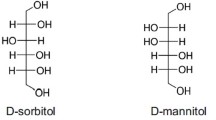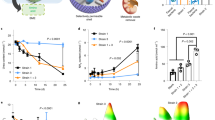Summary
The effect of D-mannose and D-glucose on bacteriuria due to Escherichia coli with mannose-sensitive adhesins was investigated in adult male Sprague-Dawley rats undergoing diuresis. Inocula of 105, 107, or 108 bacteria in 0.1 ml of normal saline or 2.5% or 10% D-mannose or D-glucose were injected intravesically and urine was cultured 1, 3, 5, 7 and 9 days later. The levels of bacteriuria on days 1 and 5 were significantly lower in rats inoculated with 105 E. coli and 10% D-mannose than in controls (p<0.05 and 0.01 respectively) and the percentages of rats with < 100 bacteria/ml were higher on days 1 and 3 (p=0.05 and 0.02 respectively). Bacteriuria was significantly lower in rats inoculated with 107 bacteria and 10% D-mannose than in controls on days 5 and 7 (p<0.01 for each day) and the percentage of rats with <100 bacteria/ml was higher on day 7 (p=0.01). D-glucose reduced bacteriuria significantly only with a concentration of 10% after instillation of 105 E. coli (p<0.05, day 1). The results indicate that D-mannose and D-glucose can significantly reduce bacteriuria within 1 day and that their efficacy is dependent upon the concentration of both saccharide and bacteria.
Similar content being viewed by others
References
Andriole VT, Epstein FH (1965) Prevention of pyelonephritis by water diuresis: Evidence for the role of medullary hypertonicity in promoting renal infection. J Clin Invest 44:73
Aronson M, Medalia O, Schori L, Mirelman D, Sharon N, Ofek I (1979) Prevention of colonization of the urinary tract of mice with Escherichia coli by blocking of bacterial adherence with methyl alpha-D-mannopyranoside. J Infect Dis 139:329
Avots-Avotins AE, Fader RC, Davis CP (1981) Environmental alteration and two distinct mechanisms of E. coli adherence to bladder epithelial cells. Invest Urol 18:364
Cox CE, Hinman F Jr (1961) Experiments with induced bacteriuria, vesical emptying and bacterial growth on the mechanism of bladder defense to infection. J Urol 86:739
Dunnett CW (1980) Pairwise multiple comparisons in the homogeneous variance unequal sample size case. J Am Stat Assoc 75:789
Fowler JE, Stamey TA (1977) Studies of introital colonization in women with recurrent urinary infections. VIII. The role of bacterial adherence. J Urol 117:472
Freedman LR (1967) Experimental pyelonephritis. XIII. On the ability of water diuresis to induce susceptibility to E. coli bacteriuria in the normal rat. Yale J Biol Med 39:255
Michaels EK, Jarow JP, Schaeffer AJ (1981) Ventral bladder hernia facilitates study of urinary tract infections in rats. Urol Res 9:249
Mulholland SG (1979) Lower urinary tract antibacterial defense mechanisms. Invest Urol 17:93
Ofek I, Beachey EH (1978) Mannose binding and epithelial cell adherence of Escherichia coli. Infect Immun 22:247
Ofek I, Mirelman D, Sharon N (1977) Adherence of Escherichia coli to human mucosal cells mediated by mannose receptors. Nature 265:623
O'Grady F, Cattell WR (1966) Kinetics of urinary tract infection. II. The bladder. Br J Urol 38:156
Orikasa SS, Hinman F Jr (1977) Reaction of the vesical wall to bacterial penetration. Resistance to attachment, desquamation and lymphocytic activity. Invest Urol 15:185
Parsons CL, Greenspan C, Mulholland SG (1975) The primary antibacterial defense mechanism of the bladder. Invest Urol 13:72
Saier MH Jr, Schmidt MR, Leibowitz M (1978) Cyclic AMP-dependent synthesis of fimbriae in Salmonella thyphimurium: Effects of cya and pts mutations. J Bacteriol 134:356
Schaeffer AJ, Amundsen SK, Jones JM (1980) Effect of carbohydrates on adherence of Escherichia coli to human urinary tract epithelial cells. Infect Immun 30:531
Schaeffer AJ, Jones JM, Dunn JK (1981) Association of in vitro Escherichia coli adherence to vaginal and buccal epithelial cells with susceptibility of women to recurrent urinary-tract infections. New Engl J Med 304:1068
Snedecor GW, Cochran WG (1967) Statistical Methods, 6th Edition, Chapter 10
Svanborg-Eden C, Eriksson B, Hanson LA, Jodal U, Kaijser B, Lidin Janson G, Lindberg U, Olling S (1978) Adhesion to normal uroepithelial cells of Escherichia coli from children with various forms of urinary tract infection. J Pediatr 93:398
Svanborg-Eden C, Hanson LA, Jodal U, Lindberg U, Sohl Akerlund A (1976) Variable adherence to normal human urinary-tract epithelial cells of Escherichia coli strains associated with various froms of urinary tract Infection. Lancet II:490
Svanborg-Eden C, Jodal U (1979) Attachment of Escherichia coli to urinary sediment epithelial cells from urinary tract infection-prone and healthy children. Infect Immun 26:837
Author information
Authors and Affiliations
Rights and permissions
About this article
Cite this article
Michaels, E.K., Chmiel, J.S., Plotkin, B.J. et al. Effect of D-mannose and D-glucose on Escherichia coli bacteriuria in rats. Urol. Res. 11, 97–102 (1983). https://doi.org/10.1007/BF00256954
Accepted:
Issue Date:
DOI: https://doi.org/10.1007/BF00256954




